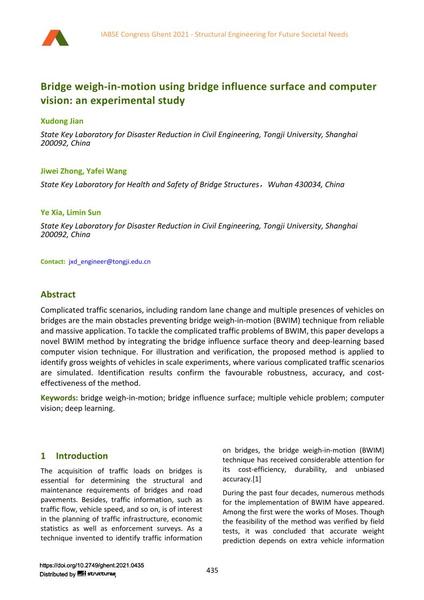Bridge weigh-in-motion using bridge influence surface and computer vision: an experimental study

|
|
|||||||||||
Bibliografische Angaben
| Autor(en): |
Xudong Jian
(State Key Laboratory for Disaster Reduction in Civil Engineering, Tongji University, Shanghai 200092, China)
Jiwei Zhong (State Key Laboratory for Health and Safety of Bridge Structures,Wuhan 430034, China) Yafei Wang (State Key Laboratory for Health and Safety of Bridge Structures,Wuhan 430034, China) Ye Xia (State Key Laboratory for Disaster Reduction in Civil Engineering, Tongji University, Shanghai 200092, China) Limin Sun |
||||
|---|---|---|---|---|---|
| Medium: | Tagungsbeitrag | ||||
| Sprache(n): | Englisch | ||||
| Tagung: | IABSE Congress: Structural Engineering for Future Societal Needs, Ghent, Belgium, 22-24 September 2021 | ||||
| Veröffentlicht in: | IABSE Congress Ghent 2021 | ||||
|
|||||
| Seite(n): | 435-440 | ||||
| Anzahl der Seiten (im PDF): | 6 | ||||
| DOI: | 10.2749/ghent.2021.0435 | ||||
| Abstrakt: |
Complicated traffic scenarios, including random lane change and multiple presences of vehicles on bridges are the main obstacles preventing bridge weigh-in-motion (BWIM) technique from reliable and massive application. To tackle the complicated traffic problems of BWIM, this paper develops a novel BWIM method by integrating the bridge influence surface theory and deep-learning based computer vision technique. For illustration and verification, the proposed method is applied to identify gross weights of vehicles in scale experiments, where various complicated traffic scenarios are simulated. Identification results confirm the favourable robustness, accuracy, and cost- effectiveness of the method. |
||||
| Copyright: | © 2021 International Association for Bridge and Structural Engineering (IABSE) | ||||
| Lizenz: | Die Urheberrechte (Copyright) für dieses Werk sind rechtlich geschützt. Es darf nicht ohne die Zustimmung des Autors/der Autorin oder Rechteinhabers/-in weiter benutzt werden. |
||||
